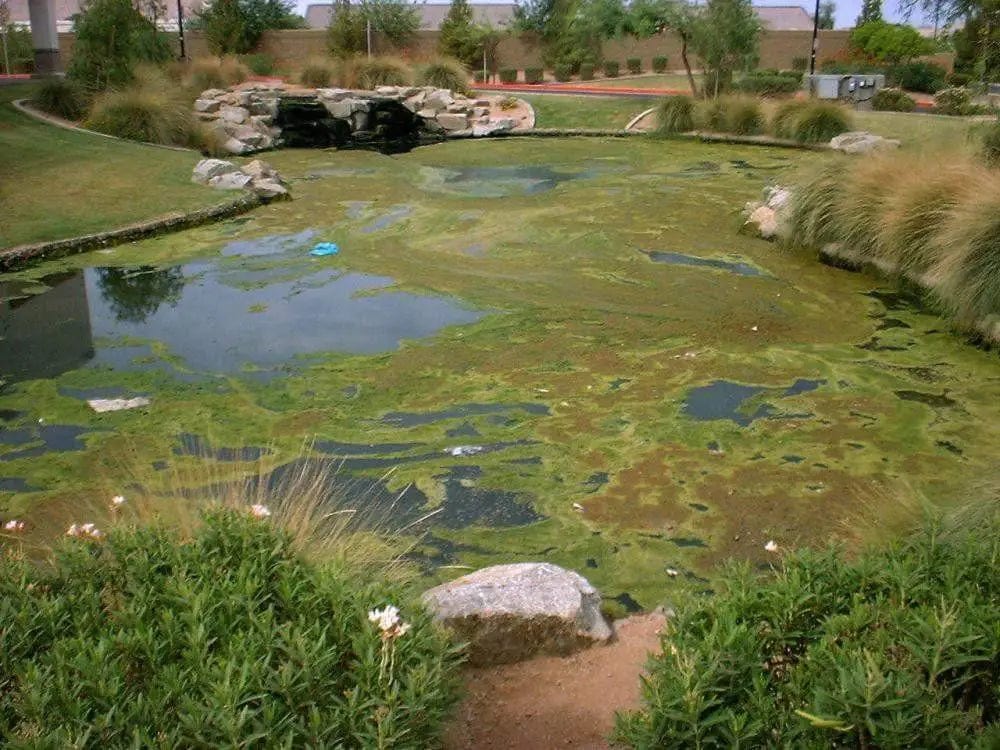Ever gaze out at your prized pond, expecting a glistening reflection, only to find it choked with green murk? Don't despair! Algae growth is a battle many pond owners face. But fear not; there's hope for a healthy, crystal-clear oasis. Let's explore various methods, from physical solutions to safe chemical treatments and manual pond algae control and removal techniques. Taking control of algae can restore your pond's beauty and create a thriving ecosystem for your fish and enjoyment.
Physical or Machine Solutions

Algae growth thrives in still, nutrient-rich waters. Luckily, physical and mechanical solutions can disrupt this ideal environment or remove the algae. Here are a few options to consider:
- Fountains and Aerators: Imagine a healthy pond ecosystem as a constantly moving party. Fountains and pond aerators get the party started by increasing water circulation, and this disrupts stagnant areas where algae love to lounge, making it harder for them to establish themselves. Plus, the extra oxygen helps promote the growth of beneficial bacteria that compete with algae for nutrients.
- Barley Straw Bales: Looking for a natural approach? Barley straw bales are a great eco-friendly option. As the barley slowly decomposes, it releases enzymes that suppress algae growth. Think of it as a natural, slow-release algae deterrent! Remember that this method works best for preventative measures and mild infestations.
The best physical solution for your pond depends on its size and the severity of the algae problem. Fountains and aerators are a great choice to keep your ecosystem thriving. Barley straw bales are a great preventative measure, especially for smaller ponds.
Non-Toxic Chemical Solutions
Non-toxic algaecides can be valuable in your pond-care arsenal when battling stubborn algae. But remember, safety first! We want to target the algae without harming fish and floating plants that share your pond.
Various types of non-toxic algaecides are available, such as pond bacteria treatment or enzyme-based options to remove algae. These products work by introducing beneficial bacteria or enzymes that compete with algae for nutrients or break down algae cell walls.
Always follow the manufacturer's instructions for application, including testing your pond's water parameters, like pH and ammonia levels, before treatment. Knowing these values helps ensure the algaecide works effectively and safely. It's also essential to use the correct dosage – too little might not be strong enough, and too much could disrupt the pond's delicate balance.
It's essential to set realistic expectations. Non-toxic fish pond algaecides might take longer to see results compared to harsher chemicals. The effectiveness can also vary depending on the type and severity of the algae bloom. However, with patience and consistent use, these solutions can be a safe and eco-friendly way to regain control of your pond's health.
Manual Algae Removal Techniques
Sometimes, the best solution is an excellent old-fashioned hands-on approach. Manual removal techniques are a great way to tackle algae, especially for more minor infestations or as a preventative measure alongside other methods. Let's explore some effective techniques:
Skimming and Netting

You want to skim off any unwanted scum or floating algae before it simmers and spoils the broth. Here's where trusty nets and skimmers come in. Regularly skimming the surface removes debris like leaves, dead plant matter, and surface algae, and this helps prevent these elements from decomposing and adding unwanted nutrients that fuel further algae growth.
Using a Pond Vacuum
Algae sometimes politely stay on the surface. Settled algae and debris can accumulate at the bottom of your pond, creating an unsightly muck layer and further disrupting the ecosystem. A pond vacuum is like a powerful underwater dustbuster! It sucks up this bottom layer, removing not just algae but also any trapped sediment or muck. Regular pond vacuuming helps maintain a clean and healthy pond environment. This method is ideal for extensive pond algae control.
Safety First!
When working in your pond, wear appropriate footwear, like waterproof boots with good tread, to prevent slipping. Gloves can also protect your hands from sharp objects or unexpected critters.
Monitoring and Maintenance to Control Algae
When everything is in balance, with plants, fish, and beneficial bacteria playing their roles, algae struggles to gain a foothold. The key is to create an environment where these natural balances keep algae in check. Here's how consistent monitoring and maintenance can help prevent algae growth:
Water Testing: Your Pond's Report Card
Think of regular water testing as giving your pond a check-up. By testing key parameters like pH, ammonia, and phosphorus levels, you can identify imbalances that might fuel more algae growth. Catching problems early on can prevent more significant issues down the road. Testing kits are readily available online or at pond supply stores like Smith Creek Fish Farm and are relatively easy to use.
Adjusting Nutrient Levels: Keeping the Balance
If your pond water testing reveals high nutrient levels, particularly phosphorus, it's time to take action. Luckily, there are natural ways to address this. Submerged plants are the heroes here! They absorb excess nutrients from the water, acting like tiny underwater filters. Adding a variety of aquatic plants helps control algae, oxygenates the water, and provides hiding spots for fish.
Fish Feeding: Feeding Frenzy or Balanced Diet?

Our finned friends can be messy eaters, and uneaten food settles at the bottom, decomposing and releasing nutrients that algae love. To avoid this, practice proper feeding habits. Feed your fish only what they can consume within a few minutes, and avoid overfeeding, especially during cooler months when their appetites decrease.
Maintenance Routines: Keeping Things Tidy
Regular maintenance routines go a long way in preventing algae problems. Here are some simple tasks to incorporate:
- Regularly removing leaves, debris, and surface scum helps prevent them from decomposing and adding nutrients to the water.
- Don't let muck accumulate on the bottom. Pond vacuuming helps remove settled algae and debris, keeping your pond clean.
- Stagnant water is an algae party invitation. Ensure proper water circulation through strategically placed pumps.
Following these practices can create a healthy and balanced pond ecosystem that naturally keeps algae at bay.
Conclusion
Battling algae can feel overwhelming, but remember, prevention is key! Regular maintenance – testing, adjustments, and cleaning – creates a healthy pond that naturally fights algae. The reward? A sparkling oasis, a thriving ecosystem for your fish, and endless enjoyment. Are you feeling lost? Many pond care services or online communities can help. Take action today and watch your dream pond come true!

